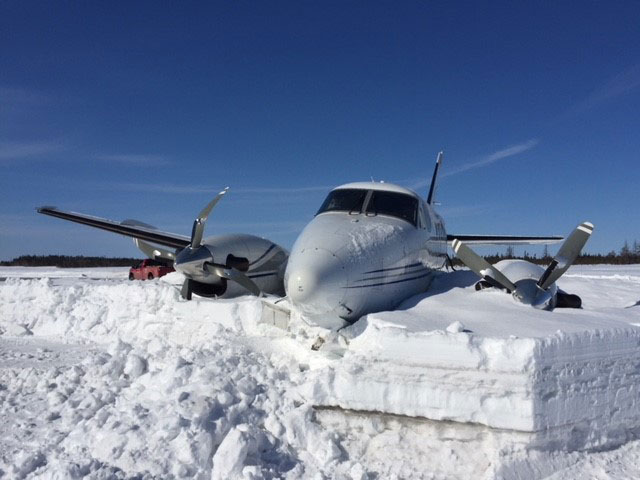Runway overrun on landing
Strait Air (2000) Ltd.
Beechcraft King Air A100, C-GJXF
Havre St-Pierre Airport, Quebec
The occurrence
On 26 February 2018 , a Beechcraft King Air A100 (registration C-GJXF, serial number B‑159) operated by Strait Air (2000) Ltd. was conducting charter flight NUK107 under instrument flight rules, from the Sept-Îles Airport, Quebec, to the Havre St-Pierre Airport, Quebec, with 2 crew members and 6 passengers on board. The aircraft conducted an approach to Runway 08, which was snow-covered, while visibility was reduced due to heavy snow showers, and landed approximately 3800 feet beyond the threshold, at approximately 700 feet from the end of the runway. It continued its landing roll beyond the runway until it came to rest in a snowbank, approximately 220 feet beyond the end of the runway. The accident occurred in daylight, at 1120 Eastern Standard Time. The emergency locator transmitter, transmitting on 406 MHz, did not activate following the occurrence. The aircraft sustained substantial damage. Four of the occupants received minor injuries.
Media materials
News release
Media advisory
Deployment notice
Investigation information
Download high-resolution photos from the TSB Flickr page.
Class of investigation
This is a class 2 investigation. These investigations are complex and involve several safety issues requiring in-depth analysis. Class 2 investigations, which frequently result in recommendations, are generally completed within 600 days. For more information, see the Policy on Occurrence Classification.
TSB investigation process
There are 3 phases to a TSB investigation
- Field phase: a team of investigators examines the occurrence site and wreckage, interviews witnesses and collects pertinent information.
- Examination and analysis phase: the TSB reviews pertinent records, tests components of the wreckage in the lab, determines the sequence of events and identifies safety deficiencies. When safety deficiencies are suspected or confirmed, the TSB advises the appropriate authority without waiting until publication of the final report.
- Report phase: a confidential draft report is approved by the Board and sent to persons and corporations who are directly concerned by the report. They then have the opportunity to dispute or correct information they believe to be incorrect. The Board considers all representations before approving the final report, which is subsequently released to the public.
For more information, see our Investigation process page.
The TSB is an independent agency that investigates air, marine, pipeline, and rail transportation occurrences. Its sole aim is the advancement of transportation safety. It is not the function of the Board to assign fault or determine civil or criminal liability.

